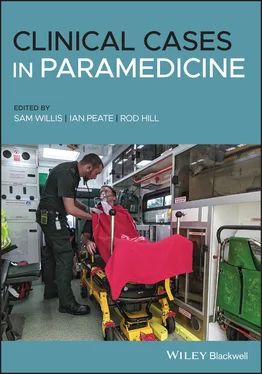Library of Congress Cataloging‐in‐Publication Data
Names: Willis, Sam, 1978– editor. | Peate, Ian, editor. | Hill, Rod (Rodney), editor.
Title: Clinical cases in paramedicine / edited by Sam Willis, Ian Peate, Rod Hill.
Description: Hoboken, NJ : Wiley‐Blackwell, 2021. | Includes bibliographical references and index.
Identifiers: LCCN 2020026984 (print) | LCCN 2020026985 (ebook) | ISBN 9781119619253 (paperback) | ISBN 9781119621041 (adobe pdf) | ISBN 9781119621034 (epub)
Subjects: MESH: Emergency Treatment | Emergency Medical Technicians | Emergencies | Problems and Exercises | Case Reports
Classification: LCC RC86.9 (print) | LCC RC86.9 (ebook) | NLM WB 18.2 | DDC 616.02/5076–dc23
LC record available at https://lccn.loc.gov/2020026984LC ebook record available at https://lccn.loc.gov/2020026985
Cover Design: Wiley
Cover Image: Courtesy of Sarah Angelou
Paramedicine is a fast‐paced, ever‐changing profession and those who practise as paramedics must be able to keep up to date with changes using the latest evidence and expert opinion where evidence does not exist. Paramedic education precedes clinical practice and therefore high‐quality learning materials are essential to prepare student paramedics for employment.
The case studies in this book bring together a diverse range of examples that accurately represent the caseload experienced by contemporary paramedics all in one place. They use a mix of evidence‐based cases and expert opinion supplied by leaders in the industry.
Case‐based learning (CBL) and problem‐based learning (PBL) rely on high‐quality, well‐written case studies that paramedic educators, students and clinicians can use to aid their understanding of out‐of‐hospital care. Not only is the content contemporary, but the cases are structured in a manner that reflects a systematic approach to each scene, allowing students to develop a sense of structure to the way they proceed in each case. Each chapter has a range of interactive learning activities that allow students to stop and think about what is going on, and the questions throughout the cases provide students with additional learning opportunities.
Joel BeakeRegistered Advanced Care Paramedic Queensland Ambulance Service Brisbane, QLD, Australia
Curtis NorthcottRegistered Advanced Care Paramedic RMA Medical Rescue and Registered Paramedic Mount Isa, QLD, Australia
Fenella CorrickGP Registrar Western Isles, Scotland, UK
David DavisCollege of Paramedics, Bridgewater, UK
Georgette EatonClinical Practice Development Manager Advanced Paramedic Practitioner (Urgent Care) London Ambulance Service, NHS Trust, London, UK
Paul GrantRegistered Paramedic Mines Emergency Rescue and Response (MERR) QLD, Australia
Yasaru GunaratneAdvanced Care Paramedic Queensland Ambulance Service, Gold Coast, QLD Australia
Alisha HensbyLecturer in Paramedicine Charles Sturt University, Bathurst, NSW, Australia
Tom HewesSenior Lecturer and Programme Director of Paramedic Sciences, Swansea University, Wales, UK
Mark HobsonClinical Practice Educator for Specialist Practice, Paramedic South Central Ambulance Service NHS Foundation Trust, Bicester, UK
Tania JohnstonLecturer in Paramedicine Charles Sturt University, Bathurst, NSW, Australia
David KryggerAdvanced Care Paramedic with Specialist Training in Low Acuity Referral Services Queensland Ambulance Service Gold Coast, QLD, Australia
Erica LeySenior HEMS Paramedic Lincolnshire and Nottinghamshire Air Ambulance Lincoln, UK Associate Lecturer in Paramedic Science University of East Anglia, Norwich, UK
Tom E. MallinsonRural GP & Paramedic BASICS Scotland, Auchterarder, UK
Kristina MaximousLecturer in Paramedicine Charles Sturt University, Bathurst, NSW, Australia
Brian MfulaLecturer in Mental Health Nursing Swansea University, Wales, UK
Georgina PickeringLecturer in Paramedicine Charles Sturt University, Bathurst, NSW, Australia
Michael PorterParamedic Queensland Ambulance Service Brisbane, QLD, Australia
Samantha SheridanLecturer in Paramedicine Charles Sturt University, Bathurst NSW, Australia
Jennifer StirlingLecturer in Paramedicine Charles Sturt University, Bathurst, NSW, Australia
Clare SuttonLecturer in Paramedicine, Discipline Group Leader Charles Sturt University, Bathurst, NSW, Australia
Sam TaylorHEMS Paramedic Air Ambulance Kent Surrey Sussex, Chatham, UK
Ruth TownsendSenior Lecturer in Paramedicine Charles Sturt University, Bathurst, NSW, Australia
Lynne WalshSenior Lecturer in Mental Health/Public Health Swansea University, Wales, UK
Steve WhitfieldLecturer/Course Convenor Griffith University, School of Medicine (Paramedicine), Gold Coast, QLD, Australia Registered Paramedic Queensland Ambulance Service Brisbane, QLD, Australia
Kerryn WrattRegistered Paramedic President, Australasian Wilderness and Expedition Medicine Society (AWEMS), Omeo, VIC, Australia CEO, Rescue MED, Omeo, VIC, Australia
Aimee YarringtonRegistered Paramedic and Registered Midwife Shropshire, UK
Chapter 1 Respiratory emergencies
Jennifer Stirling, Clare Sutton and Georgina Pickering
Charles Sturt University, Bathurst, NSW, Australia
Level 1: Asthma
Level 1: Chronic obstructive pulmonary disease (COPD)
Level 2: Pulmonary embolism (PE)
Level 2: Life‐threatening asthma
Level 3: Respiratory sepsis
Level 3: Smoke inhalation
LEVEL 1 CASE STUDY
Asthma
| Information type |
Data |
| Time of origin |
17:08 |
| Time of dispatch |
17:10 |
| On‐scene time |
17:20 |
| Day of the week |
Friday |
| Nearest hospital |
30 minutes |
| Nearest backup |
15 minutes |
| Patient details |
Name: Betsy Booper DOB:10/09/2002 |
You have been called to an outdoor running track for an 18‐year‐old female with shortness of breath. The caller states she has taken her inhaler to no effect.
The patient is conscious and breathing. You can access the area via the back gate of the sports field and drive right up to the patient, who is sat down on the track.
The location appears safe. Approx. 10 people around the patient. Environment – warm summer evening and good light.
The sports coach greets you as you get out of the ambulance and informs you that the patient suffers with exercise‐induced asthma, but this is worse than normal and her inhaler has been ineffective.
On arrival with the patient
The patient is sat on a bench on the side of the track. She is leaning forward, resting her elbows on her thighs (tripodding). She says hello as you introduce yourself to her.
Patient assessment triangle
General appearance
Alert. Speaking in short sentences. She looks panicked.
Читать дальше












